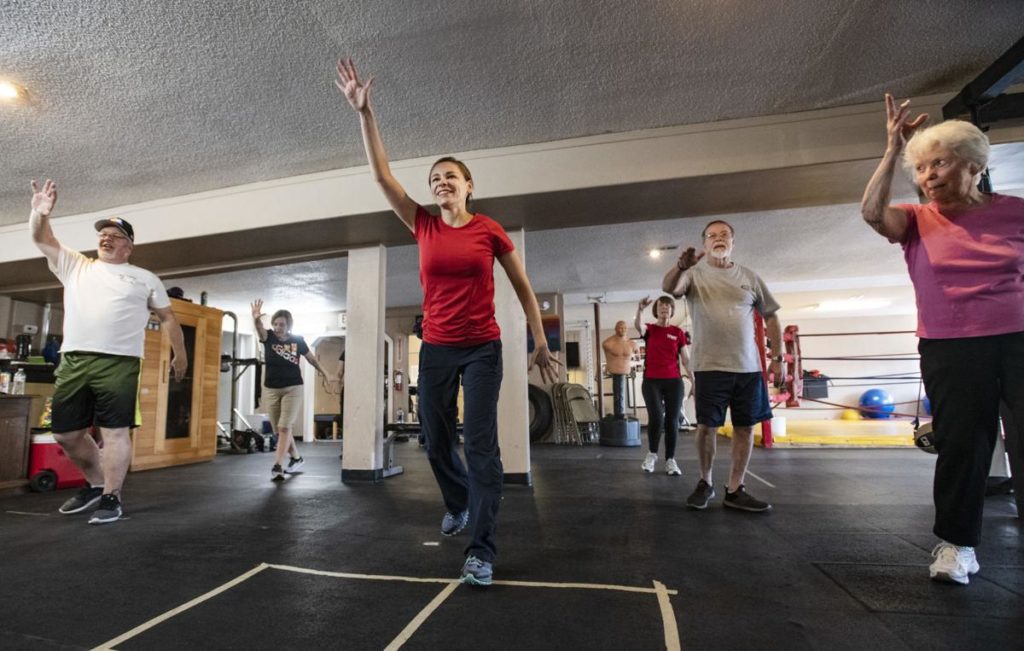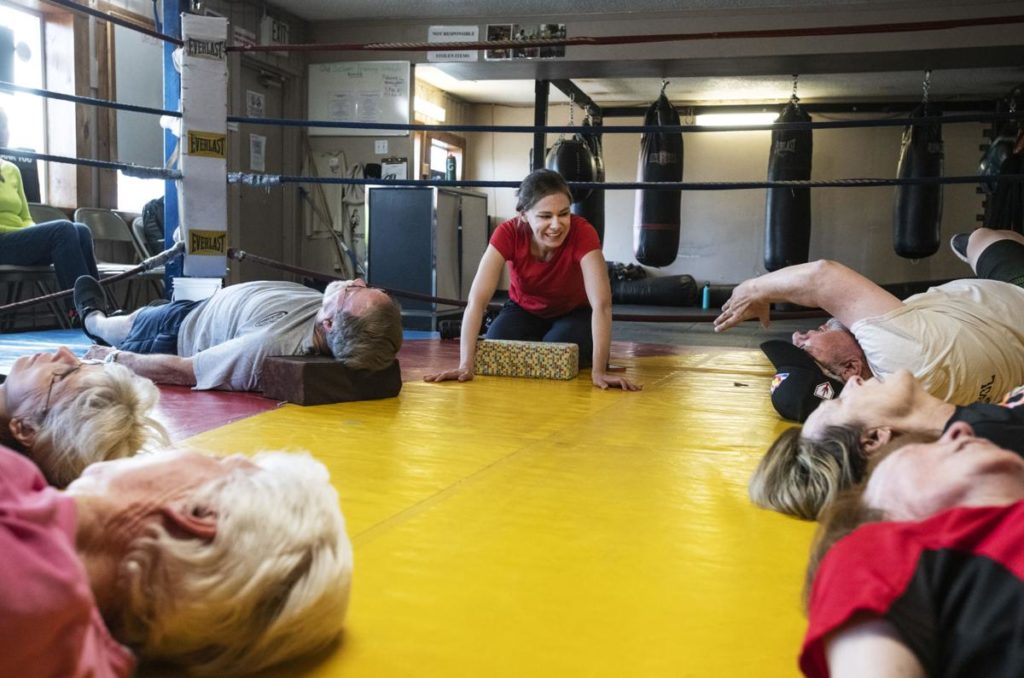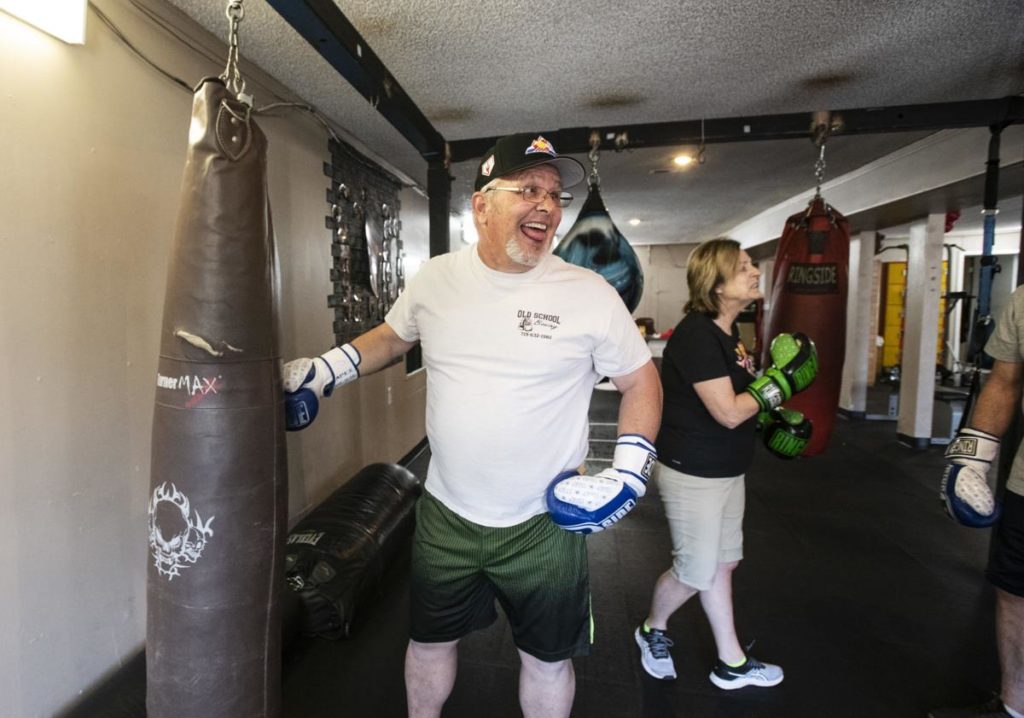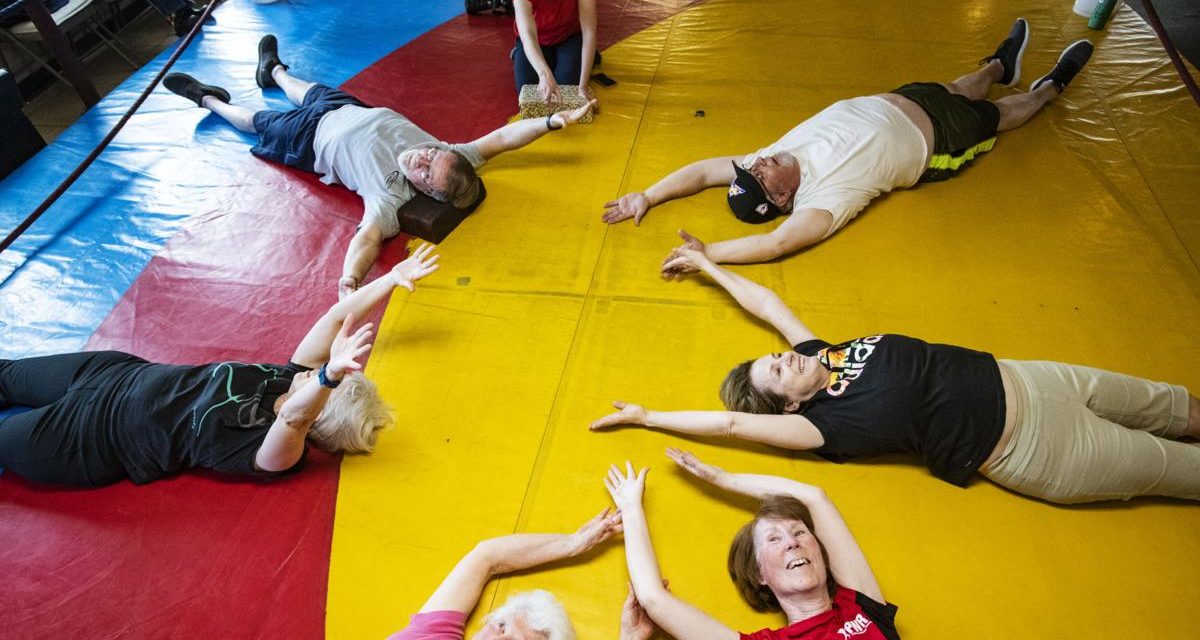The gloves come on during Emily Moncheski’s specialized fitness classes.
Her five students in this session at Old School Boxing Gym belly up to the punching bag and prepare to jab for their lives.
The two women and three men have been diagnosed with Parkinson’s disease. But they refuse to bow to the degenerative condition that can dismantle bodies over time.
They come to Moncheski to get their heart rates up, to sweat, to challenge their bodies with physical exercise that combines big movements with cognitive games. Recent research indicates high-intensity exercise is one of the best things a Parkinson’s patient can do.

Emily Moncheski, center, leads her Parkinson Wellness Recovery Bootcamp class through a set of brain exercises this month. Photo Credit: Kelsey Brunner, The Gazette
“Amplitude training — big movements — actually slows the progression of Parkinson’s,” said Moncheski, a physical therapist who specializes in working with those who have the disease. “It’s the only thing that slows the progression. Any medications just treat symptoms.”
She cites a University of Colorado study that compared people who walked on a treadmill at moderate to high intensity (based on their heart rates) with a group that walked at a self-selected pace. The latter progressed in the disease compared with those who worked at a higher intensity.
“If they went at their own leisurely pace and weren’t pushing it, they weren’t getting this symptom prevention,” Moncheski said. “It (exercise) affects neurochemicals and helps the brain make better connections.”
Actor Alan Alda revealed last year that he’d been diagnosed with Parkinson’s three and a half years earlier. He’s had a full life since, he said, and urged others not to be afraid if they were diagnosed.
“You still have things you can do,” he told The New York Times. Exercise is one of his staples: boxing three times a week, playing tennis and marching to John Philip Sousa music.
When Mary Roney was diagnosed at 62, her neurologist told her it wasn’t the end of the world and that she had 10 good years left. That wasn’t good enough for Roney, who wanted to be proactive. She found Moncheski through a Parkinson’s symposium and now does one-on-one sessions with the physical therapist, as well as her boxing and high-intensity classes. Roney also works with a personal trainer at the gym and does Nia, a nonimpact movement class that blends martial arts, dance arts and healing arts.

Emily Moncheski, center, leads the end of her PWR Bootcamp class in Colorado Springs, Monday, April, 8, 2019. Photo Credit: Kelsey Brunner, The Gazette
“I’ve stemmed the progression of it. I’m more than holding my own,” said Roney, 66. “I’ve noticed my gait has become better. My fine motor skills are better. Not that I’ve been inactive, but I’m making a focus of working out. The alternative is unacceptable to me because it’s going to hit my quality of life.”
The 55-minute, boot camp-style class begins with a disclaimer about brain games by Moncheski: “We’re doing multiple things at one time so don’t get frustrated.” With some upbeat ‘60s music in the background, she gets to work warming up the crowd. Early exercises are aimed at helping participants learn to catch themselves if they start to fall backward, while others are designed to help them practice moving their feet when they feel glued to the ground, a common Parkinson’s symptom called freezing.
Then comes the session’s main focus: big movements paired with some “brain sweat,” Moncheski said. The participants lunge forward and call out a letter of the alphabet, then lunge backward and call out ascending numbers in increments of two — a challenging task for anyone.
After a lighthearted exercise involving chairs and reacting to baby cries, dog barks and bird calls on Moncheski’s phone, she has the students enter the boxing ring and lie down, all their heads meeting in the middle in a starfish pattern. A bit more brain work coupled with some final stretches winds the class down.
Early symptoms of Parkinson’s differ by person but can include a foot that drags while walking, an arm that doesn’t naturally swing or an unnaturally quiet voice. The disease causes everything to get smaller and slower, including the voice.
Singer-songwriter Linda Ronstadt is a prime example. She noticed vocal difficulties in 2000 and was forced to retire in 2009, though her official diagnosis didn’t come until 2013.
“And then you have to learn to ask people to help, and that — that took a little doing,” she said in a CBS News report this year. “But I do that now, because I need the help.”
It’s why Moncheski has her clients make big movements and get loud while doing it.
“A person with Parkinson’s needs to be challenged,” she said. “It needs to be novel and new. No class looks the same. It helps keep their attention. And when they’re engaged, that’s when the brain makes new connections. It’s neuroplasticity.”

Dave Lohman, 66, shares a laugh with his fellow students in the PWR Bootcamp class. Photo Credit: Kelsey Brunner, The Gazette
It’s improving thinking while moving, which is what life requires of us all. Picking up the phone while talking to somebody and not tripping is usually second nature but can be challenging for Parkinson’s patients as they lose the neurotransmitter dopamine. Moncheski’s exercises are designed to improve balance by training the brain to switch tasks quickly while maintaining quality of movement.
“We’re rewiring that area of the brain that relies on dopamine. We’re using a different section of the brain versus the automatic section you and I get to use,” she said. “We don’t have to think about swinging our arms as we walk. It just happens. That’s because of dopamine. People with Parkinson’s don’t have that. If we say pick up your foot or swing your arm, they can do it by accessing the motor control area of the brain.”
The ideal amount of exercise for those with Parkinson’s is three to five days a week of 20 to 30 minutes of high intensity cardio paired with balance, strengthening and cognitive engagement. Attending a class with others who have the disease also provides community and social benefits.
Moncheski has seen firsthand the effectiveness of the protocol. It propelled her to complete Parkinson Wellness Training four years ago and begin offering classes.
“I started seeing people get better and was hooked,” she said. “I’ve had people come to classes and go back to their doctor, who almost second-guesses their diagnosis because they’re not progressing. You expect Parkinson’s to progress.”
Roney is still in the first of Parkinson’s five stages. A trembling right hand initially got her to the doctor. Late last year, she was put on a dopamine drug, but in the face of a degenerative disease, she feels as if she’s winning if she’s holding her own.
“Everybody’s on something different and different doses,” Roney said. “It’s a really perplexing disease to figure out. They want to cure it, but I’d be happy if they were able to find something that stemmed it.”
 Emily Moncheski, at top center, leads her Parkinson Wellness Recovery Bootcamp camp in final exercises at the Old School Boxing Gym in Colorado Springs this month. Photo Credit: Kelsey Brunner, The Gazette
Emily Moncheski, at top center, leads her Parkinson Wellness Recovery Bootcamp camp in final exercises at the Old School Boxing Gym in Colorado Springs this month. Photo Credit: Kelsey Brunner, The Gazette 



Comment on: High-intensity exercise shown to slow progression of Parkinson’s